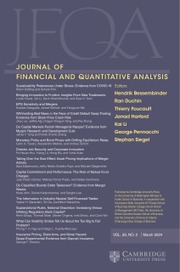Article contents
Green Pressure, Lean Measures: Unveiling Corporate Downsizing Within the European Union Emissions Trading System
Published online by Cambridge University Press: 31 March 2025
Abstract
In 2017, the European Union Emissions Trading System underwent a policy intervention that resulted in a surge in carbon prices. Using this setting as a quasi-natural experiment, we focus on employment, productivity, and emission outcomes among covered enterprises. Results show that emission-intensive private firms, particularly those with financial constraints, are more likely to downsize by divesting production assets, reducing both workforce and emissions. Smaller, cash-strapped listed firms are also prone to downsize by decreasing their operating leverage while maintaining emission output and asset levels. Positive productivity outcomes indicate that both private and listed firms become leaner postintervention.
Information
- Type
- Research Article
- Information
- Copyright
- © The Author(s), 2025. Published by Cambridge University Press on behalf of the Michael G. Foster School of Business, University of Washington
Footnotes
We are grateful to Ran Duchin (the editor) and an anonymous reviewer for their constructive comments and feedback. We would also like to thank Jan Abrell, Frank Betz, Nico Dewaelheyns, Marie Dutordoir, Hans Degryse, Ashita Goyal, Stefanie Kleimeier, Xinyu Liu, Maurizio Montone, Frederiek Schoubben, Naciye Sekerci, and Gertjan Verdickt. We are also grateful to seminar participants at the 2023 Belgium Environmental Economics Day, the 2023 World Finance Conference, the 2023 World Finance and Banking Symposium, and the 2024 Finance and Accounting Research Symposium.
References
- 1
- Cited by

